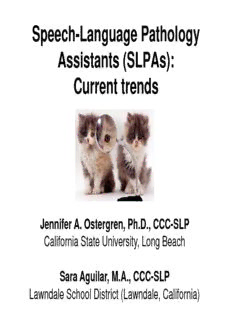
Ostergren & Aguilar, 2014 PDF
Preview Ostergren & Aguilar, 2014
Speech-Language Pathology Assistants (SLPAs): Current trends Jennifer A. Ostergren, Ph.D., CCC-SLP California State University, Long Beach Sara Aguilar, M.A., CCC-SLP Lawndale School District (Lawndale, California) Disclosures Jennifer Ostergren Sara Aguilar I have no relevant I have no relevant nonfinancial financial or relationship(s); however, nonfinancial I am the author of a book relationship(s) within on the topic of speech- the products or language pathology services described, assistants (SLPAs) for reviewed, evaluated which I receive royalties or compared in this from Plural Publishing for presentation. the sales of this book. •ASHA’s 2013 Scope of Practice for SLPAs: New Additions/Changes •Landscape of SLPAs in the United States •Educational Models and Career Ladders for SLPAs •Key Issues in Supervision of SLPAs •Legal and Ethical Issues •Resources on SLPAs •ASHA’s 2013 Scope of Practice for SLPAs: New Additions/Changes •Landscape of SLPAs in the United States •Educational Models and Career Ladders for SLPAs •Key Issues in Supervision of SLPAs •Legal and Ethical Issues •Resources on SLPAs SLPAs Defined (ASHA, 2013, Executive Summary) “Speech-language pathology assistants (SLPAs), perform tasks as prescribed, directed, and supervised by ASHA-certified speech-language pathologists (SLPs)” (ASHA, 2013) SLPAs differ from aides and other support personnel in “their degree of training and, correspondingly, in the types of responsibilities that can be assigned to them ” (ASHA, 2004, pg. 4). SLPAs Defined: CAN and IF (ASHA, 2013, Executive Summary) “Some tasks, procedures, or activities used to treat individuals with communication and related disorders CAN be performed successfully by individuals other than SLPs IF the persons conducting the activity are properly trained and supervised by ASHA-certified and/or licensed SLPs.” SLPAs CAN be used to “increase the availability, frequency, and efficiency of services” IF, “the decision to shift responsibility for implementation of the more repetitive, mechanical, or routine clinical activities to SLPAs…..[is] made only by qualified professionals and only when the quality of care and level of professionalism will not be compromised. IDEA/ESEA: IF and CAN The Individuals with Disabilities Education Improvement Act of 2004 (IDEA 2004): Section 300.156(b)(2)(iii) of the IDEA 2004 "allows paraprofessionals and assistants who are appropriately trained and supervised, in accordance with State law, regulation, or written policy,...to be used to assist in the provision of special education and related services...to children with disabilities.“ Elementary and Secondary Education Act (ESEA): Title I of ESEA, also allows the use of "properly trained paraprofessionals" who work under the direct supervision of highly qualified teachers and who may be used to "reinforce and augment a teacher's effort in the classroom." The role and use of paraprofessionals is defined in this non-regulatory guidance paper [PDF]. (American Speech-Language-Hearing Association (n.d.). Speech-Language Pathology Assistants. (Practice Portal). Retrieved November 1, 2014, from www.asha.org/Practice-Portal/Professional-Issues/Speech-Language-Pathology- Assistants) SLPAs Defined: Practice Settings (ASHA, 2013, Practice Settings) “Under the specified guidance and supervision of an ASHA- certified SLP, SLPAs may provide services in a wide variety of settings, which may include, but are not limited to, the following: •Public, private, and charter elementary and secondary schools; •Early intervention settings, preschools, and day care settings; •Hospitals (in- and outpatient); •Residential health care settings •Nonresidential health care settings •Private practice settings; •University/college clinics; •Research facilities; •Corporate and industrial settings; •Student/patient/client's residences.” ASHA Responsibilities of an SLPA (ASHA, 2013) • Activities INSIDE the Scope of an SLPA •Service Delivery •Administrative Support •Prevention and Advocacy •Activities OUTSIDE the Scope of an SLPA INSIDE the Scope of an SLPA: Service Delivery (ASHA, 2013, Service Delivery) • Self-identify as SLPAs. This may be done verbally, in writing, and/or with titles on name badges. • Exhibit compliance with HIPAA and FERPA regulations, reimbursement requirements, and SLPAs' responsibilities. • Assist the SLP with speech, language, and hearing screenings without clinical interpretation. • Assist the SLP during assessment of students, patients, and clients exclusive of administration and/or interpretation • Document student, patient, and client performance (e.g., tallying data for the SLP to use; preparing charts, records, and graphs) and report this information to the supervising SLP.
Description: